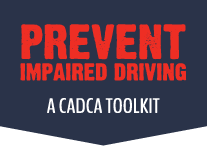About the Toolkit
Alcohol-impaired driving crashes still account for one-third of all traffic-related deaths in the United States. The annual cost of alcohol-related crashes totals more than $44 billion. Facts such as these continue to drive efforts in communities around the country to reduce driving under the influence. CADCA, through the support of NHTSA, has developed an Impaired Driving Resource Kit to aid community efforts with the latest research and evidence-based strategies.
CADCA’s Impaired Driving Resource Kit is designed to provide coalitions, law enforcement partners and drug prevention practitioners with strategies to prevent and reduce impaired driving in their communities. Equipped with the findings from key research in the field, the Resource Kit’s Impaired Driving Prevention Strategies highlight CADCA’s 7 Strategies for Effective Community Change, with an emphasis on an environmental approach, and detail specific evidence-based policy interventions. Grounded in the field of public health, environmental strategies offer well-accepted prevention approaches that coalitions can use to change the context (or environment) in which impaired driving occurs.
The Resource Kit offers a variety of strategies aimed at changing or influencing community conditions, standards, institutions, systems and policies.
Impaired Driving Facts-at-a-Glance
Alcohol-Impaired Driving Facts
Impaired Driving Toolkit
Research Resources
June 2021
Cole, T. B., & Saitz, R. (2020). Cannabis and Impaired Driving. JAMA, 324(21), 2163–2164. https://doi.org/10.1001/jama.2020.18544
Fell J. C. (2019). Approaches for reducing alcohol-impaired driving: Evidence-based legislation, law enforcement strategies, sanctions, and alcohol-control policies. Forensic science review, 31(2), 161–184.
Ginsburg B. C. (2019). Strengths and limitations of two cannabis-impaired driving detection methods: a review of the literature. The American journal of drug and alcohol abuse, 45(6), 610–622. https://doi.org/10.1080/00952990.2019.1655568
Høye A. (2020). Speeding and impaired driving in fatal crashes-Results from in-depth investigations. Traffic injury prevention, 21(7), 425–430. https://doi.org/10.1080/15389588.2020.1775822
Motschman, C. A., Hatz, L. E., McCarty, K. N., Merkle, E. C., Trull, T. J., & McCarthy, D. M. (2020). Event-Level Predictors of Alcohol-Impaired Driving Intentions. Journal of studies on alcohol and drugs, 81(5), 647–654. https://doi.org/10.15288/jsad.2020.81.647
Roberts, W., Moore, K. E., Pittman, B. P., Fillmore, M. T., & McKee, S. A. (2019). High Risk of Alcohol-Impaired Driving in Adults With Comorbid Alcohol and Substance Use Disorders in the U.S. Population. Journal of studies on alcohol and drugs, 80(1), 114–119. https://doi.org/10.15288/jsad.2019.80.114
Rosekind, M. R., Ehsani, J. P., & Michael, J. P. (2020). Reducing Impaired Driving Fatalities: Data Need to Drive Testing, Enforcement, and Policy. JAMA internal medicine, 180(8), 1068–1069. https://doi.org/10.1001/jamainternmed.2020.1984
Teutsch, S. M., & Naimi, T. S. (2018). Eliminating Alcohol-Impaired Driving Fatalities: What Can Be Done?. Annals of internal medicine, 168(8), 587–589. https://doi.org/10.7326/M18-0069
Tiscione, N. B., Alford, I. K., Miller, R., Shan, X., & Yeatman, D. T. (2019). Driving Under the Influence of Drugs: When the Law Misses the Mark. Journal of analytical toxicology, 43(2), 138–143. https://doi.org/10.1093/jat/bky070
Vivoda, J. M., Walker, R. M., Cao, J., & Koumoutzis, A. (2020). How Accumulated Wealth Affects Driving Reduction and Cessation. The Gerontologist, 60(7), 1273–1281. https://doi.org/10.1093/geront/gnaa039

